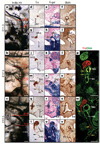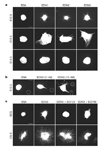Endothelins are vascular-derived axonal guidance cues for developing sympathetic neurons
- PMID: 18401410
- PMCID: PMC2713667
- DOI: 10.1038/nature06859
Endothelins are vascular-derived axonal guidance cues for developing sympathetic neurons
Abstract
During development, sympathetic neurons extend axons along a myriad of distinct trajectories, often consisting of arteries, to innervate one of a large variety of distinct final target tissues. Whether or not subsets of neurons within complex sympathetic ganglia are predetermined to innervate select end-organs is unknown. Here we demonstrate in mouse embryos that the endothelin family member Edn3 (ref. 1), acting through the endothelin receptor EdnrA (refs 2, 3), directs extension of axons of a subset of sympathetic neurons from the superior cervical ganglion to a preferred intermediate target, the external carotid artery, which serves as the gateway to select targets, including the salivary glands. These findings establish a previously unknown mechanism of axonal pathfinding involving vascular-derived endothelins, and have broad implications for endothelins as general mediators of axonal growth and guidance in the developing nervous system. Moreover, they suggest a model in which newborn sympathetic neurons distinguish and choose between distinct vascular trajectories to innervate their appropriate end organs.
Figures




References
-
- Arai H, Hori S, Aramori I, Ohkubo H, Nakanishi S. Cloning and expression of a cDNA encoding an endothelin receptor. Nature. 1990;348:730–732. - PubMed
-
- Sakurai T, et al. Cloning of a cDNA encoding a non-isopeptide-selective subtype of the endothelin receptor. Nature. 1990;348:732–735. - PubMed
-
- Schotzinger RJ, Landis SC. Cholinergic phenotype developed by noradrenergic sympathetic neurons after innervation of a novel cholinergic target in vivo. Nature. 1988;335:637–639. - PubMed
Publication types
MeSH terms
Substances
Associated data
- Actions

